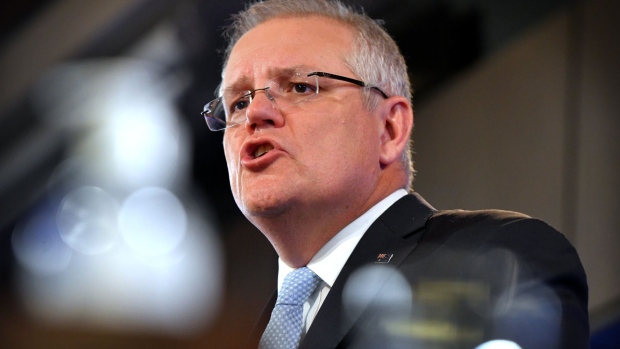Jun 30, 2020
Australia’s Defense Spend to Surge Amid Contest in Indo-Pacific
, Bloomberg News

(Bloomberg) -- Prime Minister Scott Morrison will announce an overhaul of Australia’s defense strategy and force structure, as the U.S. ally looks to counter an increasingly assertive China in an Indo-Pacific region he calls “the focus of the dominant global contest of our age.”
In a major speech to be delivered in Canberra on Wednesday, Morrison is set to announce that his government will spend A$270 billion ($185 billion) in defense capability over the next decade, up from about A$195 billion when the nation’s previous strategic overhaul was announced in 2016.
The spending will include Australia‘s purchase of AGM-158C Long Range Anti-Ship Missiles from the U.S. Navy for about A$800 million, tripling the range of its maritime strike capability to about 230 miles.
In a sign that Morrison’s defense and intelligence network sees the threat of actual military engagement with an enemy in its region growing, Australia will alter the focus of its 2016 Defence White Paper, which included an eye toward support around the globe for the rules-based order -- such as its aerial support of the U.S. coalition in Iraq and Syria.
Instead, Australia will in the future limit its geographical focus to its immediate region -- “the area ranging from the north-east Indian Ocean, through maritime and mainland Southeast Asia to Papua New Guinea and the South West Pacific.”
“We remain prepared to make military contributions outside of our immediate region where it is in our national interest to do so, including in support of U.S.-led coalitions,” Morrison will say. “But we cannot allow consideration of such contingencies to drive our force structure to the detriment of ensuring we have credible capability to respond to any challenge in our immediate region.”
China Tensions
The renewed focus in protecting Australia’s immediate borders may reflect the nation’s concerns about being exposed by an increasingly distracted U.S. ally led by President Donald Trump, whose administration has shown disdain for some of his nation’s traditional alliances.
Though China remains Australia’s largest trading partner, relations between the two nations have become increasingly fraught since 2018, when Morrison’s government banned Huawei Technologies Co. from building its 5G network on national security grounds.
That year, it also said Beijing’s “meddling” was a catalyst for legislation designed to halt foreign interference in its governments, media and education sector.
Relations have only worsened since April, when Australian Foreign Minister Marise Payne said an independent probe should be allowed to operate in the mainland city of Wuhan to investigate the origins of the coronavirus.
China has imposed crippling tariffs on Australia’s barley industry, halted beef imports from four meat plants, and urged its tourists and students to avoid going to the nation due to the risk of attacks from racists.
In a seeming reference to recent tensions with Beijing, Morrison will say in the speech that “coercive activities are rife” and “disinformation and foreign interference have been enabled by new and emerging technologies.”
He said June 19 that Australia’s government, health and education services and various industries were being targeted by a “sophisticated” actor conducting state-based cyber attacks that some defense academics said was likely China.
“These must be able to hold potential adversaries’ forces and infrastructure at risk from greater distance, and therefore influence their calculus of costs involved in threatening Australian interests,” Morrison will say Wednesday. “This includes developing capabilities in areas such as longer-range strike weapons, cyber capabilities and area-denial systems.”
Increased Spending
Since coming to power in 2013, Morrison’s conservatives say they have increased the nation’s defense spending from 1.56% of gross domestic product -- the lowest level since 1938 -- to an estimated 2% this year “despite the many pressures on the budget.”
In that period, the government has committed to building new frigates in a deal with BAE Systems Plc worth A$35 billion and to 12 submarines built by France’s Naval Group SA in an agreement estimated in 2016 to be worth A$50 billion. It’s also buying 72 Joint Strike Fighters estimated in 2018 at A$115.7 million each.
The 2020 Force Structure Plan to be announced by Morrison on Wednesday now includes plans for the acquisition or upgrade of up to 23 different classes of navy and army vessels, representing a total investment of as much as A$183 billion.
Australia needs to “prepare for a post-Covid world that is poorer, more dangerous and more disorderly,” Morrison will say. “We have moved into a new and less benign strategic era –- one in which the institutions and patterns of cooperation that have benefited our prosperity and security for decades are under increasing strain.”
A breakdown of the A$270 billion defense spending budget over the next 10 years includes:
- Maritime, A$75 billion - including capability for anti-submarine warfare, sea-lift, border security, maritime patrol, aerial warfare, area denial and undersea warfare; and up to A$500 million in long-range maritime strike missiles
- Air, A$65 billion – including expanded air combat and mobility and new long range weapons and remotely piloted and autonomous systems; and up to A$17 billion in fighter aircraft
- Land, A$55 billion – Including up to A$11.1 billion on future autonomous vehicles; up to A$11.5 billion for long range rocket fires and artillery systems including two regiments of self-propelled howitzers; and up to A$2.1 billion for army watercraft
- Defense Enterprise, A$50 billion – Investments in key infrastructure and information and communications technology; up to A$10.2 billion in undersea warfare facilities and infrastructure
- Information and cyber, A$15 billion - To bolster offensive and defensive cyber capabilities, enhance electronic warfare and command and control systems and improve intelligence, surveillance and reconnaissance systems
- Space, A$7 billion - Investment to improve resilience and self-reliance, including to assure access to capabilities, enable situational awareness and deliver real-time communications and position, navigation and timing; up to A$6.9 billion in upgrades and future satellite communications systems
©2020 Bloomberg L.P.





